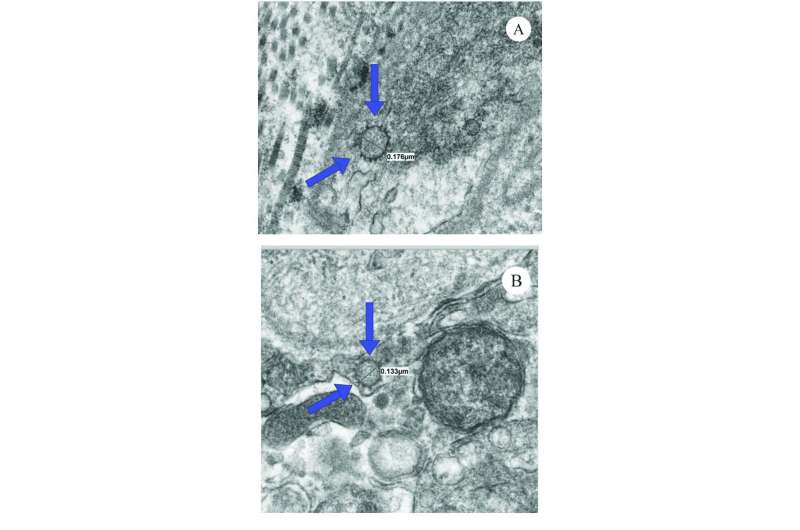Ultrastructure features of penile tissue from live seroconverted COVID-19 patients. (A) Coronavirus-like spiked viral particles (arrows) visualized via TEM in the peri-vascular erectile tissue of a live patient who had previously contracted the COVID-19 virus and subsequently seroconverted. Particle diameter measurement indicated on image. (B) Coronavirus-like spiked viral particles (arrows) visualized via TEM in the peri-vascular erectile tissue of a live patient who had previously contracted the Covid-19 virus and subsequently seroconverted. Particle diameter measurement indicated on image. Credit: Dr. Ranjith Ramasamy/University of Miami Health System
University of Miami Miller School of Medicine researchers are the first to demonstrate that COVID-19 can be present in the penis tissue long after men recover from the virus.
The widespread blood vessel dysfunction, or endothelial dysfunction, that results from the COVID-19 infection could then contribute to erectile dysfunction, or ED, according to the study recently published in the World Journal of Men's Health. Endothelial dysfunction is a condition in which the lining of the small blood vessels fails to perform all of its functions normally. As a result, the tissues supplied by those vessels could undergo damage.
"Our research shows that COVID-19 can cause widespread endothelial dysfunction in organ systems beyond the lungs and kidneys. The underlying endothelial dysfunction that happens because of COVID-19 can enter the endothelial cells and affect many organs, including the penis," said study author Ranjith Ramasamy, M.D., associate professor and director of the Miller School's Reproductive Urology Program. "In our pilot study, we found that men who previously did not complain of erectile dysfunction developed pretty severe erectile dysfunction after the onset of COVID-19 infection."
Dr. Ramasamy and colleagues collected penile tissue from two men with a history of COVID-19 infection who underwent penile prosthesis surgery for ED. One of the men was hospitalized for COVID-19, while the other patient only had mild symptoms when he contracted the virus.
The researchers also collected tissue from two additional men with no history of COVID-19 infection undergoing the same surgery for ED. The investigators analyzed all the tissue samples for not only evidence of the virus but also endothelial dysfunction.
They found COVID-19 was present in the penile tissue of both men who had been infected, but not in the men with no history of the virus. The men had been infected six and eight months prior, respectively. These men had evidence of endothelial dysfunction, while the men who had been free of the virus did not.
"This suggests that men who develop COVID-19 infection should be aware that erectile dysfunction could be an adverse effect of the virus, and they should go to a physician if they develop ED symptoms," Dr. Ramasamy said.
The authors hypothesize that similar to other COVID-19 related complications, widespread infection and subsequent endothelial dysfunction could result in ED, and that worsening of ED could be due to the virus's presence in the penile tissue, itself.
In a previously published study, Dr. Ramasamy and Miller School colleagues found that COVID-19 can also invade testis tissue in some men who are infected with the virus, which might be the first step in understanding the virus's potential impact on male fertility and whether COVID-19 can be sexually transmitted.
"These latest findings are yet another reason that we should all do our best to avoid COVID-19," said first author Eliyahu Kresch, a medical student working with Dr. Ramasamy.
"We recommend vaccination and to try to stay safe in general," Kresch said.
More information: Eliyahu Kresch et al. COVID-19 Endothelial Dysfunction Can Cause Erectile Dysfunction: Histopathological, Immunohistochemical, and Ultrastructural Study of the Human Penis, The World Journal of Men's Health (2021). DOI: 10.5534/wjmh.210055
























